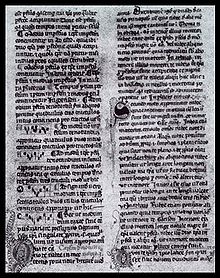Ars nova (music)
Ars nova ( Latin for new art ) is an epoch of music history in France in the 14th century that replaced the Ars antiqua . During this time, a highly developed, largely polyphonic vocal music was created . Occasionally the term is used more generally for the development of polyphonic music in Europe as a whole in the 14th century.
Demarcation
The name goes back to the title of the treatise Ars nova , which is attributed to Philippe de Vitry and which was published around 1322/23. In the corresponding article of the MGG , however, it is doubted that this was at all a formal, programmatic treatise. Another important treatise is the recently written Notitia artis musicae by the music theorist Johannes de Muris , in which the new, improved mensural notation is explained, which greatly expanded the possibilities of notation for rhythm . It was based on these that were created during this time, if one compares it with the works of Ars antiqua, harmoniously and rhythmically very complex and differentiated compositions that are thoroughly emotionally motivated and at the same time highly expressive. Specifically, two-stage imperfect divisions of the note values have now also been accepted and used. Previously there were almost exclusively tripartitions, the necessity of which was derived from the Trinity of God. The poet-musician Guillaume de Machaut combined various compositional means in his Mass de Nostre Dame and found an expression that was previously unheard of. It went down in music history as the first composition of the musical parts of the ordinarium by a single, well-known composer.
Rejection
When it appears, ars nova encounters fierce resistance from the advocates of ancient art ( ars antiqua ) under its spokesman, James of Liège . When Pope John XXII. in the bull Docta sanctorum patrum 1322 forbids the performance of new music in the church, the music finds support and support especially among the courtly nobility; In this environment, secular forms of music are increasingly emerging.
Genera
In addition to the motet, the predominant genres of Ars nova are various polyphonic song forms ( ballad , rondeau , virelai ). Isoperiodics and isorhythmics develop as formal compositional principles . The highlight of the development is the isorhythmic motet.
Composers
The outstanding artists of the Ars nova were u. a. Philippe de Vitry and Guillaume de Machaut (around 1300–1377). The earliest source for the new style is the manuscript F-Pn146, which includes the Roman de Fauvel . Ivrea's manuscript (I-IV 115) was probably made in the south-east of France and, with a total of 37 motets, is the most extensive surviving collection of motets in Ars Nova. Three motets are attributed to Machaut. That is relatively certain, because they are also contained in the manuscript Machaut 2 (F-Pn 1586). Vitry are also attributed the motets contained.
Continuation
The Italian equivalent or further development of the Ars nova led to the so-called Trecento notation, which offered comparable but slightly different possibilities for differentiating the note values. The best-known Italian composer of this time was Francesco Landini . Ars subtilior , which continued into the 15th century , can be seen as a kind of continuation or subsidiary branch of Ars nova .
